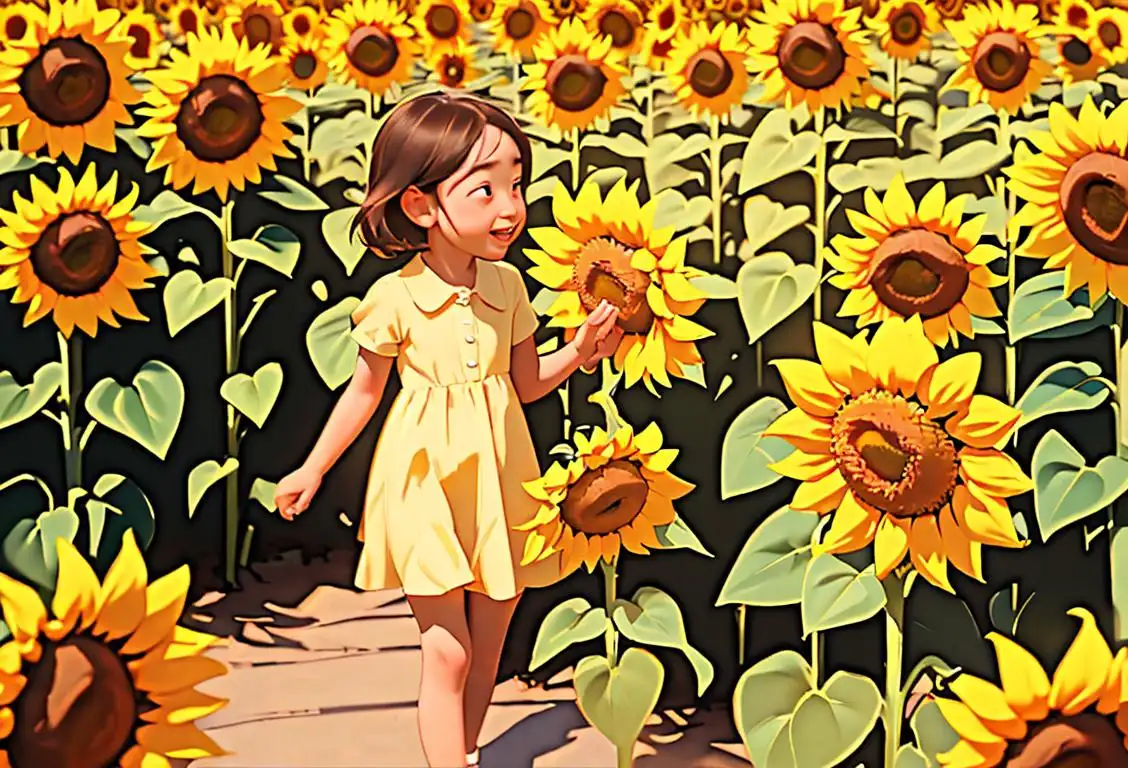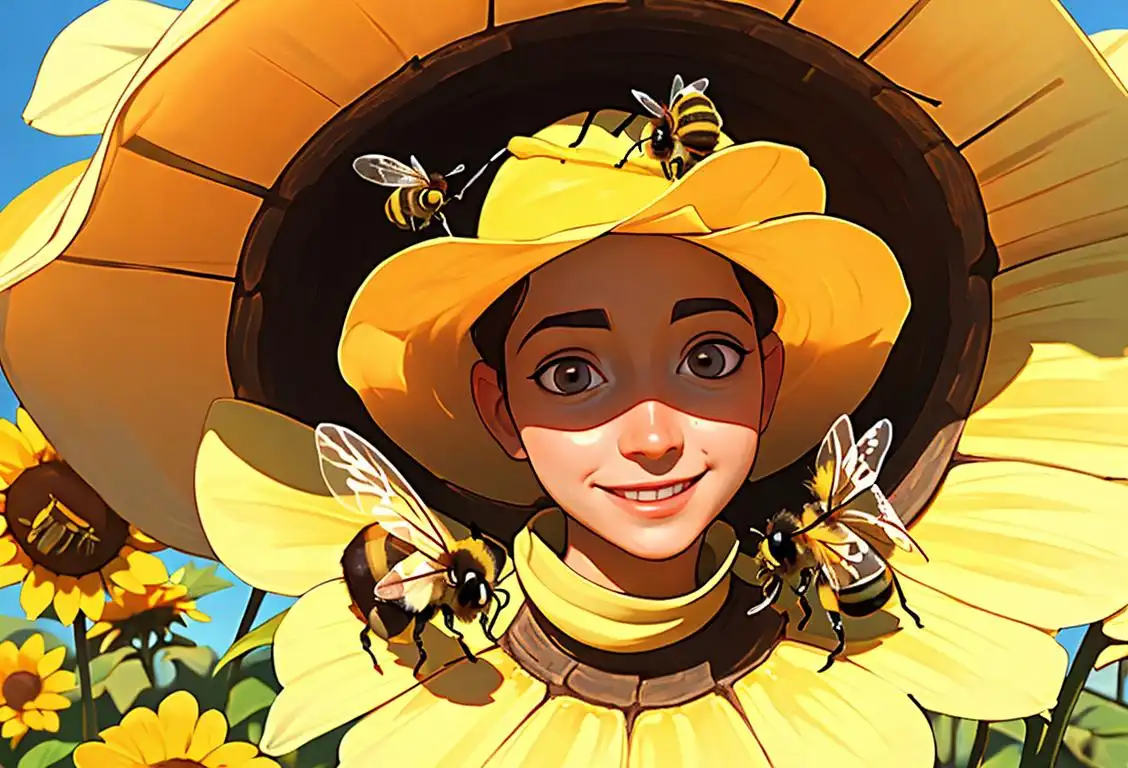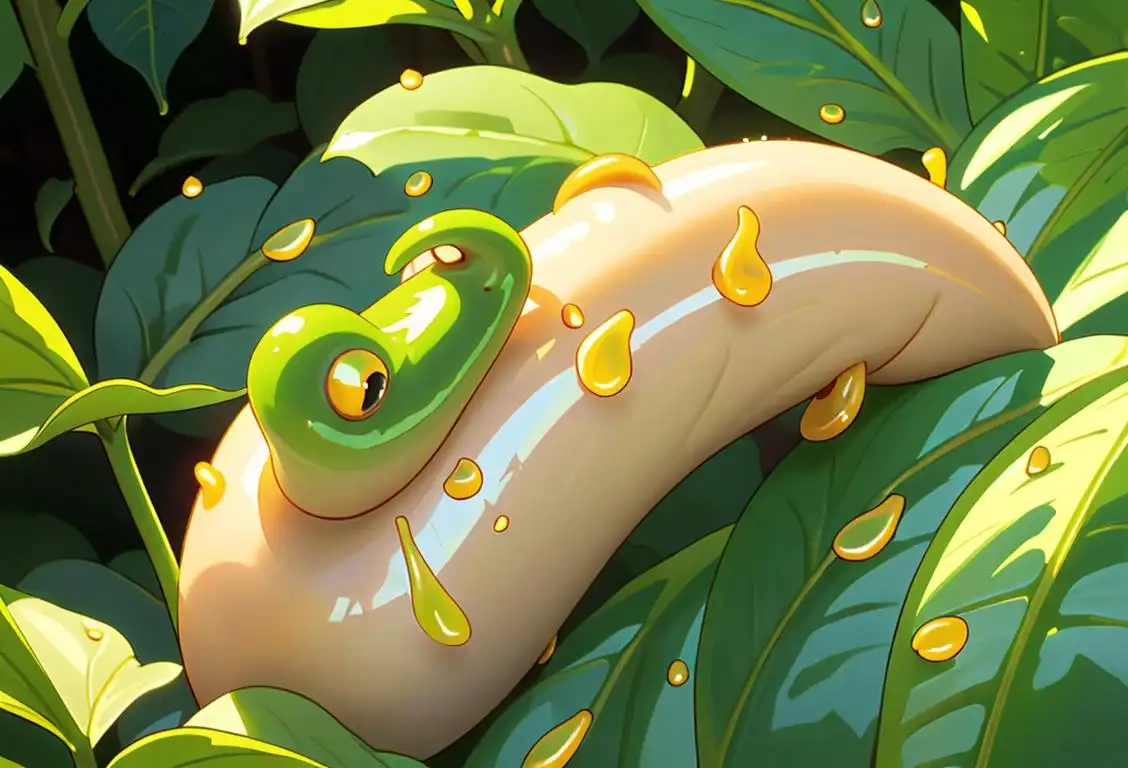National Sunflower Day

If a sunflower turned its dizzying, yellow head to watch the calendar dates, it would greet the 15th of August with its biggest sun-lit smile! Welcome folks, to a swirl of sunshine on a stand - it's National Sunflower Day.
When is Sunflower Day?
It's national sunflower day on the 15th August.
Shining Light on National Sunflower Day
From Van Gogh's iconic painting to the humble backyard plot, sunflowers have a way of inspiring joy and optimism. Every year, on August 15th, we celebrate this cheerful flora with National Sunflower Day, a day first marked in the online world in 2017. Few flowers can throw a party quite like the sunflower, and the internet went aglow with 23 mentions in that first year, much like a well-stocked sunflower field in full bloom.
The Sunflower’s Place in History
Did you know that sunflowers have a history as rich and vibrant as their golden petals? Sunflowers have been lighting up our world for thousands of years, originally cultivated by Native Americans who used them for food, oil, and dye. This day, therefore, connects us with a heritage that’s both natural and cultural, a chance to remember and celebrate this resilient and resourceful plant.
Why the Sunflower?
The sunflower is a symbol of adoration, longevity, and loyalty. Much like the sun it takes its name from, the sunflower often symbolizes warmth, happiness and unwavering faith. It's not just a pretty face in the flower world, though- this bright bloom is hard-working, producing seeds that sustain and help humans and wildlife alike. So, it’s pretty obvious why we’d swing a special calendar day in their honor, right?
How to Celebrate
Whether you’re an avid gardener, a flower enthusiast, or just someone who enjoys random and fun holidays, you can join in on the sunflower celebration. Plant a sunflower, start a sunflower painting, or make a sunflower-inspired meal - go nuts (or should we say go seeds?). Whatever you do, remember to share your lovely sunflower moments on social media to help the awareness of this cheerful day grow, like a sunflower reaching for the sky.
History behind the term 'Sunflower'
2600 BCE
The Cultivated Cultural Marvel
Sunflowers are believed to have originated in North America around 2600 BCE. Native Americans were the first to cultivate these beautiful plants for their versatile uses. They used them as a source of food, oil, and dye, as well as for medicinal purposes. Sunflowers quickly became a vital part of Native American culture, symbolizing strength, positivity, and a connection to nature.
2600 BCE
Domestication of the Sunflower
Around 2600 BCE, sunflowers were first domesticated by Native Americans in what is now present-day Mexico and the southern United States. These early cultivators recognized the sunflower's value both as a food source and as a symbol of spiritual significance. They used the seeds for sustenance, ground them into flour, and extracted oil for cooking and medicinal purposes.
2600 BCE
Ancient Cultivation
The history of sunflowers dates back to around 2600 BCE when they were first cultivated by indigenous people in present-day Mexico and the southwestern United States. These early farmers recognized the beauty and usefulness of sunflowers, using them for food, oil, and even medicinal purposes. The sunflower plants were highly revered due to their striking appearance and their ability to follow the sun's path during the day, a phenomenon known as heliotropism.
2600 BC
Ancient Cultivation
The history of the sunflower dates back to around 2600 BC, where it was first cultivated by Native Americans in what is now present-day Mexico and the southwestern United States. Native Americans used sunflowers for both food and oil, and they also recognized their medicinal properties.
5000 BCE
Early Cultivation
The history of the term 'sunflower' can be traced back to around 5000 BCE when Native Americans in what is now present-day Mexico started cultivating the sunflower for its abundant crop of seeds. The native peoples of North America made use of the sunflower in various ways, including as a source of food, oil, dye, and medicine.
3000 BCE
Cultivation in Mesoamerica
The history of sunflowers can be traced back to around 3000 BCE in Mesoamerica, where they were first cultivated by indigenous peoples. The plant held great significance to various cultures like the Aztecs and Incas, who saw it as a symbol of the sun and used its seeds for food and oil. It was not only a vital crop but also played a role in religious ceremonies and as a medicine.
5000 BCE
Ancient cultivation
Sunflowers were first cultivated by Native Americans in present-day North America, particularly in what is now Mexico and the southwestern United States. These early sunflowers were primarily grown for their nutritious seeds, which were a valuable food source. The Native Americans also used various parts of the sunflower plant for medicinal and ceremonial purposes.
16th Century
Introduction to Europe
The sunflower reached Europe in the early 16th century, thanks to Spanish explorers who brought back seeds from the Americas. Initially, it was mostly grown as an ornamental plant in gardens due to its large and vibrant flower heads. However, its importance as a food and oil crop gradually spread, with cultivation expanding across the continent.
16th Century
Sunflowers Encounter Europe
During the 16th century, Spanish explorers brought sunflower seeds from the Americas back to Europe. These seeds captured the interest of European botanists and attracted attention due to their unique characteristics, particularly the distinctive large flower heads that follow the movement of the sun. Sunflowers rapidly gained popularity among European gardeners and became cherished additions to horticultural collections.
16th Century
European Introduction
Sunflowers reached Europe in the 16th century through Spanish explorers, who brought the seeds back from the Americas. Initially, sunflowers were primarily grown as ornamental flowers in European gardens. The bright yellow petals and the sheer height of the sunflower plants captivated the European aristocracy, soon making them a sought-after symbol of beauty and prosperity.
16th century
Introduction to Europe
Explorers from Europe, such as Spanish conquistadors, encountered sunflowers during their expeditions to the New World. They were captivated by the distinctive appearance of the sunflower and its versatile uses. Sunflowers were brought back to Europe and quickly gained popularity as ornamental plants in gardens across the continent.
16th Century
Arrival in Europe
Sunflowers made their way to Europe in the 16th century when Spanish explorers brought them back from the Americas. They were initially grown as ornamental plants in European gardens due to their vibrant yellow petals and unique appearance.
16th Century
European Discovery
The term 'sunflower' gained prominence in the 16th century when Spanish explorers encountered the plant during their voyages to the Americas. They were fascinated by its bright yellow petals, which reminded them of the sun, and hence named it 'sunflower'. The sunflower was subsequently introduced to other parts of the world, including Europe, where it gained popularity as a decorative plant.
16th Century
European Discovery and Spread
In the 16th century, Spanish explorers encountered the sunflower during their travels in the Americas. Captivated by its sunny appearance and practical uses, they brought sunflower seeds back to Europe. It didn't take long for the sunflower to gain popularity throughout the continent, with cultivation spreading rapidly across countries like Russia and Ukraine.
18th Century
From Gardens to Fields
In the 18th century, sunflowers expanded beyond ornamental gardens. Their attributes, including their ability to grow in poor soil conditions, led to their cultivation as an oilseed crop, initially in Russia. Sunflower oil quickly gained prominence due to its nutritional value and versatility in cooking and cosmetics. The plant's emergence as a significant agricultural commodity propelled its popularity worldwide.
18th Century
Oil Production
During the 18th century, sunflowers gained popularity for their oil production. Sunflower oil became an important ingredient in cooking and candle-making. The seeds were easily pressed to extract the oil, making it a cost-effective and widely available product.
18th century
Oil production begins
In the 18th century, Russian farmers began cultivating sunflowers on a larger scale for oil production. The high oil content of sunflower seeds made them an excellent source for extracting oil. This marked a significant shift in the cultivation of sunflowers, as they were no longer solely grown for their seeds but also for the valuable oil they produced.
18th Century
Industrial Uses
By the 18th century, sunflowers had gained popularity as a commercial crop, particularly in Eastern Europe and Russia. These regions embraced sunflower cultivation for its oil-producing capabilities. The oil extracted from the seeds was used for cooking, soap-making, and even as a lubricant for machinery. The robust nature of the plant made it well-suited for large-scale cultivation.
18th Century
Scientific Classification
In the 18th century, the sunflower was scientifically classified by Swedish botanist Carl Linnaeus. He gave it the scientific name Helianthus annuus, derived from the Greek words 'helios' meaning sun and 'anthos' meaning flower. This scientific classification solidified the term 'sunflower' as the common name for this distinctive plant.
18th Century
Sunflower Oil Production
By the 18th century, sunflowers gained recognition for their versatile oil properties. The production of sunflower oil became prevalent, particularly in Russia, due to the relatively high oil content of the sunflower seeds. Russian farmers, appreciating the sunflower's adaptability to their climate, discovered its potential as a valuable oilseed crop, leading to the widespread cultivation of sunflowers throughout the region.
18th Century
Scientific Classification
During the 18th century, Swedish botanist Carl Linnaeus formally classified the sunflower and gave it the scientific name Helianthus annuus. Linnaeus appreciated the unique nature of the sunflower, especially its ability to track the sun's movement. The name Helianthus combines the Greek words 'helios' (sun) and 'anthos' (flower).
19th Century
Development of Varieties
During the 19th century, notable advancements were made in the development of different sunflower varieties. Russian breeders played a significant role in creating hybrids with higher oil content. The introduction of hybridization techniques paved the way for sunflowers to become a more economically valuable crop, allowing for increased oil production and better adaptability to various climates.
19th Century
Sunflowers in Art
The 19th century witnessed a surge in sunflower popularity, particularly in the realm of art. One prominent artist associated with sunflowers is Vincent van Gogh, who created his iconic series of sunflower paintings between 1887 and 1889. Van Gogh's expressive brushstrokes and vibrant colors encapsulate the beauty and symbolism of the sunflower, making it a lasting motif in artistic representations of nature.
19th Century
Influence on Art and Literature
During the 19th century, sunflowers greatly influenced the world of art and literature. The renowned Dutch painter, Vincent van Gogh, created a series of vibrant still-life paintings featuring sunflowers as the main subject, showcasing their symbolic meaning of happiness and vitality. Sunflowers also became a recurring motif in poetry and literature of this era, representing beauty, optimism, and the cycle of life.
19th Century
Commercial Cultivation
During the 19th century, the cultivation of sunflowers expanded beyond their native regions as they became popular as a commercial crop. The oil extracted from sunflower seeds gained recognition for its culinary and industrial uses. Ukraine emerged as a major producer of sunflowers, and the country's landscapes became adorned with vast fields of these vibrant flowers.
19th Century
Vincent van Gogh's Sunflowers
Vincent van Gogh, the renowned Dutch painter, immortalized sunflowers in a series of paintings created between 1887 and 1889. These vibrant and iconic works depict sunflowers in various stages of bloom, reflecting van Gogh's fascination with their beauty and symbolism. The persistence of these masterpieces has perpetuated the association of sunflowers with artistic expression, radiance, and joy.
19th Century
Russian Cultivation
The 19th century marked a significant turning point in sunflower cultivation. Russian farmers started growing sunflowers on a larger scale, leading to a surge in sunflower oil production. This boom in the industry eventually made Russia one of the major exporters of sunflower oil in the world.
19th century
Commercial cultivation in the United States
During the 19th century, sunflowers started being commercially cultivated in the United States, particularly in states like Kansas, known as the 'Sunflower State.' The booming oil industry further contributed to the expansion of sunflower cultivation, as the oil was utilized for various purposes, including cooking and soap production.
20th Century
Commercialization and Modern Uses
In the 20th century, sunflowers transitioned from primarily being grown for their seeds and oil to a variety of commercial applications. The oil extracted from sunflower seeds became a popular cooking oil due to its high smoke point and heart-healthy properties. Additionally, sunflower seeds gained popularity as a snack food and as an ingredient in baking and confectionery products.
20th century
Hybridization and modern varieties
Advancements in plant breeding and hybridization techniques during the 20th century led to the development of new sunflower varieties with improved traits. These modern varieties offered higher yields, different colors, and differing growth habits. Sunflowers became even more popular, not only for their practical uses but also as decorative flowers in gardens and floral arrangements.
20th Century
Symbolism and Artistic Influence
The sunflower gained significant symbolism and artistic influence in the 20th century. Artists such as Vincent van Gogh depicted sunflowers in their famous paintings, showcasing their beauty and capturing their essence as a symbol of vitality and joy. The sunflower's association with the sun also led to its representation as a symbol of worship, happiness, and positivity.
20th Century
Global Sunflower Production and Associations
In the 20th century, sunflower cultivation became widespread, particularly in countries like Russia, Ukraine, Argentina, and the United States. These nations became major producers of both sunflower oil and seeds. Moreover, sunflowers gained further significance as an emblem in various cultures, representing happiness, adoration, and loyalty. They found their way into literature, poetry, and popular culture, becoming a symbolic and aesthetic motif.
20th Century
Commercialization and Modern Uses
In the 20th century, the commercialization of sunflower products expanded significantly. Sunflower cultivation became a global industry, primarily for the production of oilseeds, including both vegetable oil and snacks made from roasted sunflower seeds. Furthermore, sunflower seeds gained popularity as a healthy and nutritious snack option due to their high vitamin and mineral content. Today, sunflowers continue to be an important crop worldwide, providing various products, brightening gardens, and reminding us of their enduring cultural significance.
20th Century
Deeper Cultural Symbolism
In the 20th century, the sunflower began to take on a deeper cultural symbolism. Artists and writers drew inspiration from its cheerful appearance, associating it with concepts such as happiness, adoration, and loyalty. The sunflower also became a symbol of hope and resilience.
20th Century
Global Expansion
The 20th century witnessed the global expansion of sunflower cultivation as it became a major agricultural crop in various countries. The United States, Argentina, Ukraine, and Russia emerged as significant producers, with the majority of the world's sunflower oil being produced in these regions. Sunflowers also found their way into the art world, inspiring renowned artists like Vincent van Gogh.
1996
National Sunflower Day in the United States
In 1996, the National Sunflower Association of the United States designated August 28th as National Sunflower Day. This day celebrates the beauty and versatility of sunflowers, highlighting their cultural and agricultural significance. It's a day to appreciate the vibrant and cheery presence of sunflowers in our lives and to recognize their economic importance as a valuable crop.
Present Day
Versatile Crop
Today, sunflowers are grown in various parts of the world for their oil-rich seeds, which find use in cooking, confectionery, and skincare products. They continue to be admired for their beauty and are often included in floral arrangements and garden landscapes. The sunflower's popularity persists as it remains a beloved symbol of positivity and vitality.
21st Century
Renewed Interest and Sunflower Tourism
In recent years, there has been a resurgence of interest in sunflowers for their aesthetic appeal. Sunflower fields have become popular tourist attractions, drawing visitors from around the world to witness their vibrant blooms. Festivals celebrating the beauty and significance of sunflowers have also gained prominence, creating opportunities for people to engage with the cultural, artistic, and agricultural aspects of these iconic flowers.
Did you know?
Did you know that sunflowers have been to space? That's correct, in 2012 astronaut Don Pettit brought along spindly sunflower greens on a trip to the NASA space station.Tagged
awareness fun gardening history nature sunflower artFirst identified
15th August 2017Most mentioned on
15th August 2017Total mentions
23Other days
Sunflower Day
Bee Lovers Day
Slug Day
Bourbon Day
Former Prisoner Of War Recognition Day
Liberation Day
Teacher Appreciation Day
Memorial Day
Convention Day
Vodka Day








